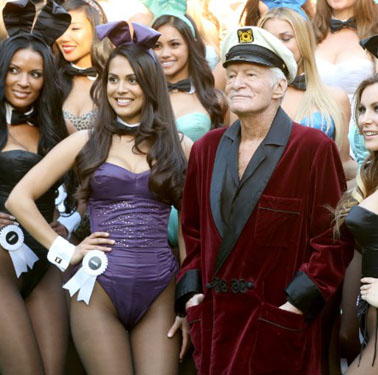Ave atque vale Hugh Hefner : “one of a handful of people who most represent the sexual revolution” .. maybe ??
Sep 29th, 2017 | By Dominic Berry | Category: In Brief
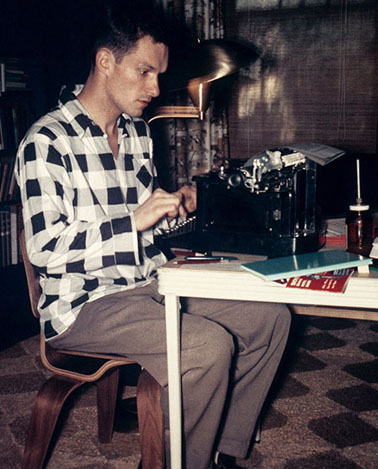
“Hefner works on the first issue of Playboy magazine in his Chicago apartment,” 1953. (Photo provided by Playboy Enterprises.)
Like others, no doubt, I haven’t looked at a copy of Playboy magazine for a great many years. And I never subscribed or otherwise read the articles (or looked at the photos) regularly.
But for a time in the late 1950s and 1960s, it was something young men my age were expected to know about and take an interest in. The recent death of founder Hugh Hefner, at the impressive age of 91, does seem a milestone of sorts in my life.
I don’t have a lot to say – and certainly I can offer no unique analysis.
I can only point to four main sources on the subject I bumped into, during a morning’s research-homage to a man who, in his own words, was “one of a handful of people who most represent the sexual revolution” in the North America where I grew up :
(1) My first source is a long obituary from the Los Angeles Times : “Playboy founder Hugh Hefner, who shook up American morality with an ideal of swinging singlehood, dies at 91.” I thought it did a nice job of surveying the Hefner career in easily digested prose.
(2) “Hugh Hefner Fast Facts” from the “CNN Library” does an equally nice job of summarizing the career in even more easily digested bullet points.
(3) These days I often find Wikipedia articles much better than the reputation which preceded them for quite a while. And I found the Wkipedia article on “Playboy … an American men’s lifestyle and entertainment magazine” quite helpful in this case.
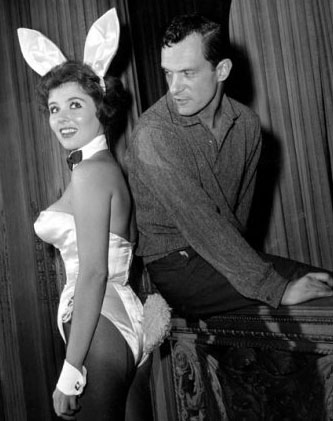
Hugh Hefner poses with "bunny-girl hostess" Bonnie J. Halpin at the Playboy Club in Chicago, June 20, 1961. (ED KITCH / THE ASSOCIATED PRESS FILE PHOTO).
(4) One thing I can remember hearing by word of mouth back in the late 1950s and early 1960s was that Miles Davis had declined a Playboy jazz award because the magazine did not have black playmates. (This changed with Jennifer Jackson in the March 1965 issue : see Josh Robertson on “A History of Black Playboy Playmates,” February 1, 2013.) Whatever the exact truth may be here, the black journalist Alex Haley (of later Roots fame) finally interviewed Miles Davis for Playboy in 1962, and the interview was published in the September issue that year. As the “Jerry Jazz Musician” website aptly opined in April 2016, Mr. Davis’s 1962 “opinions on race, politics and culture continue to be important … a reminder of the complexity of American life.” (And this seems even more to the point in the early autumn of 2017.)
From these four main sources (and a few related articles) I have assembled a quick-and-dirty chronology of top 10 non-fake facts that still intrigue me. It is followed by an extra bow to the 1962 Miles Davis interview, and a wild guess about a present-day trend Hugh Hefner at least reminds me of, that has nothing directly to do with sex. (Granting that many, many things are indirectly connected this way, of course … ) :
Top 10 non-fake facts …
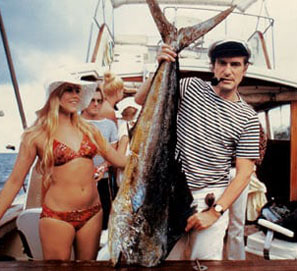
“Barbi Benton and Hugh Hefner, Miami 1970 Photograph: 2009 PLAYBOY ENTERPRISES INTERNATIONAL, INC. / TASCHEN.”
* The first issue of Playboy magazine appeared in December 1953. It was “undated, as Hefner was unsure there would be a second. He produced it in his Hyde Park [Chicago] kitchen. The first centerfold was Marilyn Monroe, although the picture used originally was taken for a calendar rather than for Playboy” (Wikipedia).
* HH buys the “the first Playboy Mansion in Chicago” in December 1959 (CNN Fast Facts).
* The first Playboy Club opened in Chicago in 1960. “Over the next three decades, the enterprise grew into a chain of 35 clubs and three resorts, including casinos, stretching from Los Angeles to the Bahamas” (LA Times).
* The “clubs, like the magazine, became a lightning rod for feminist dissent. [Gloria] Steinem’s 1963 expose portrayed the Bunnies as victims of exploitation, who were poorly paid … In a 1983 postscript to the article, Steinem concluded grimly that ‘all women are Bunnies.’ By the end of the 1980s, there were no more Playboy Clubs in the US” (LA Times).
* HH buys “the Playboy Mansion West in Holmby Hills, California” in 1971 (CNN Fast Facts … and see “Hugh Hefner’s Playboy Mansion was hedonistic headquarters for his brand” in yesterday’s LA Times).
* “The best-selling Playboy edition was the November 1972 edition, which sold 7,161,561 copies. One-quarter of all American college men were buying or subscribing to the magazine every month” (Wikipedia).

The Playboy Mansion in Holmby Hills, California. Hef finally sold it to a neighbour, while retaining the right to live in the place until his death. In its heyday, the lovely Canadian Pamela Anderson has explained : “Playboy Mansion was like my university. It was full of intellectuals, sex, rock ‘n’ roll, art, all the important stuff.”
* “Hefner would not show everything, believing some modesty would bolster his magazine’s chances for success. Thus, he banned pubic hair and genitalia, airbrushing away all traces. He held to these strictures until 1971, when competition from Bob Guccione’s Penthouse convinced him to allow more graphic poses of Playmates. The field grew more crowded and explicit with Larry Flynt’s Hustler, which began publishing in 1974” (LA Times).
* In 1988 “Hefner steps down as chairman and CEO, and his daughter, Christie, takes control.” In 1992 he “Purchases the crypt next to Marilyn Monroe’s in the Westwood Village Memorial Park cemetery [in Los Angeles] for $75,000” (CNN Fast Facts).
* “In 2004, when the magazine celebrated its 50th anniversary, its circulation of about 3 million was less than half what it had been in the 1970s, outdone by brasher magazines and Internet porn sites, and the numbers would continue to decline” (LA Times).
* “Hefner will be laid to rest in a Westwood crypt beside Marilyn Monroe, whose nude pictures helped launch Hefner into history. As he told The Times in 2009, ‘Spending eternity next to Marilyn is too sweet to pass up’” (LA Times).
Miles smiles and the surge in one-person households
Before concluding, I’d also like to quickly note some thoughts from Miles Davis in his September 1962 Playboy interview with Alex Haley : “I don’t stay long on the road. I like to have time at home to be with my kids and Frances, and to just think about things –Â like worrying about the people running this government maybe slipping and getting us into another war. But I like them Kennedy brothers –Â they’re swinging people … I got everything a man could want –Â if it just wasn’t for this prejudice crap. It ain’t that I’m mad at white people, I just see what I see …Â This whole prejudice mess is something you would feel so good if it could just be got rid of, like a big sore eating inside of your belly.”
Now, finally here is my wild guess about a present-day trend Hugh Hefner at least reminds me of, that has nothing directly to do with sex. Did/does his “ideal of swinging singlehood” (also LA Times)Â have anything to do with the growing trend towards one-person households of the past several decades, especially prevalent among various playboys (and girls) of the western world?
Note that in the USA : “A hundred years ago, fewer than 6% of all households consisted of people who lived alone. In 2013, 28% of households were single-person, making it the second most common household type just behind married couples without children.”
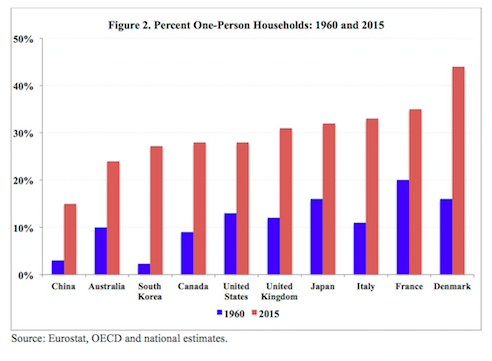 For particular Canadian evidence on this trend (lately virtually identical numerically to the US case, it seems) see : “Census 2016: A rise and changes in one-person households” ; and “Canada has more same-sex couples, one-person households, census shows.
For particular Canadian evidence on this trend (lately virtually identical numerically to the US case, it seems) see : “Census 2016: A rise and changes in one-person households” ; and “Canada has more same-sex couples, one-person households, census shows.
At the same time, if Hugh Hefner and Playboy have essentially been North American phenomena (in the narrow sense of the United States and Canada), it is worth also noting that the trend towards one-person households has been stronger in, eg, the United Kingdom, Japan, Italy, France, and Denmark than in either the United States or Canada. (See “The Rise of One-Person Households” by Joseph Chamie, a former director of the United Nations Population Division.)
Or maybe Hugh Hefner and Playboy have been somewhat more global phenomena than at least people like me give them credit for ???? Or they themselves just reflected broader trends, inside and outside the USA ????
